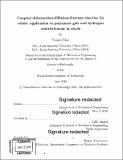Coupled deformation-diffusion-fracture theories for solids : application to polymeric gels and hydrogen embrittlement in steels
Author(s)
Mao, Yunwei
DownloadFull printable version (24.46Mb)
Other Contributors
Massachusetts Institute of Technology. Department of Mechanical Engineering.
Advisor
Lallit Anand.
Terms of use
Metadata
Show full item recordAbstract
Solids with deformation-diffusion coupling are ubiquitous in engineering applications. Understanding and modeling the fracture of such solids is vitally important. This thesis addresses the theoretical formulation, numerical implementation, and application of fully-coupled deformation-diffusion-damage theories for two different classes of materials: (i) polymeric gels and (ii) hydrogen embrittlement in steels, as elaborated below. (i) Fracture of polymeric gels: We first introduce a field called "stretch of Kuhn segments and/or crosslinks", which is necessary for understanding and modeling of the fracture in polymeric materials. Together with this newly introduced field, we formulate a thermodynamically consistent phase-field type theory for fracture of gels. A central feature of our theory is the recognition that the free energy of polymeric materials is not entirely entropic in nature, there is also an energetic contribution from the deformation of the backbone bonds in a chain and/or the crosslinks. It is this energetic part of the free energy that drives the progressive damage and fracture of polymeric materials. We have implemented our theory in a finite element code, and used this simulation capability to study some interesting phenomena in failure of elastomers and gels. (ii) Fracture of steels due to hydrogen embrittlement: We have formulated a thermodynamically consistent theory for the diffusion of hydrogen coupled with the large elastic-plastic deformations, and a phase-field type theory to model ductile fracture of metals. The theory accounts for the macroscopic effects due to the generation and agglomeration of microscopic hydrogen-vacancy complexes. We have implemented our fully coupled theory in a finite element program, and calibrated the material parameters in the theory by using experimental data available in the literature. Finally we have utilized our simulation capability to study the process of fracture due to hydrogen embrittlement in some technically relevant notched-components made from steel.
Description
Thesis: Ph. D., Massachusetts Institute of Technology, Department of Mechanical Engineering, 2018. Cataloged from PDF version of thesis. Includes bibliographical references (pages 207-216).
Date issued
2018Department
Massachusetts Institute of Technology. Department of Mechanical EngineeringPublisher
Massachusetts Institute of Technology
Keywords
Mechanical Engineering.